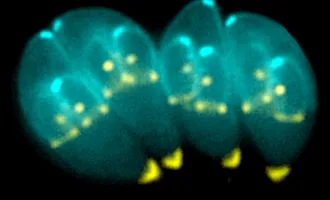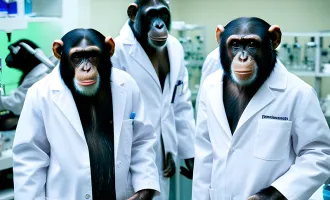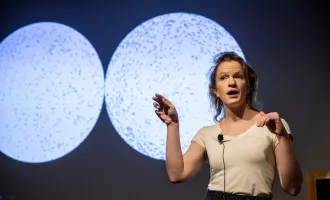Scientists Seek to Engineer Microbes to Make Simple Chemicals
In a lab in Emeryville not much bigger than a garage, three scientists are trying to show there is a better way to make chemicals used in everyday items. If they’re right, they’ll be able to prevent millions of pounds of carbon dioxide from entering the atmosphere every year while lowering the cost of producing a range of goods from compost bags to yoga pants.
Elizabeth Clarke, Derek Greenfield, and Noah Helman are the founders of Industrial Microbes. They are developing a novel method of using microbes to create chemicals with broad industrial applications, a method they anticipate will be cheaper and produce a smaller carbon footprint than current practices.
Their goal is to develop an organism that can use carbon dioxide and methane as starting materials to make industrial useful chemicals such as malic and succinic acid. These are in turn used for making biopolymers such as biodegradable plastics and synthetic fibers.
"Several other companies are going after succinic acid using sugar as a raw material. We are really excited about accessing cheaper carbon," she said. "Methane is one fourth of the price of sugar and CO2 is even cheaper than that." Three of the four carbons in malic acid will come from methane with the other coming from CO2.
Clarke said, "We did a life-cycle analysis, comparing the standard petroleum route to malic acid with our proposed pathway. The petroleum pathway is dirty and emits a lot of CO2. Our process of making malic acid is a lot greener than the traditional route."
This aspect was particularly attractive to the CCEMC (Climate Change and Emissions Management Corp.), a Canadian-based non-profit with the goal of reducing CO2 emissions in Alberta. The CCEMC gave Industrial Microbes their first startup money to develop a metabolic pathway that consumes CO2.
The biosynthesis of malic acid from sugar has been previously demonstrated. In contrast, the efficient oxidation of methane has proven difficult to implement. Their goal is to genetically engineer industrial strains to oxidize methane using enzymes and pathways derived from methanotrophs, organisms that already use methane as an energy source.
"Existing companies are trying to engineer methane-consuming organisms to make various products because of the low price (of using methane). They are going after known methanotrophs," said Clarke. "What’s tricky about these organisms is that they are not well-characterized organisms and they are hard to engineer. We are going after industrially proven host strains that are well studied.”
"The core lessen we took from working at LS9 and watching companies like Amyris and Solazyme is that when you have an expensive raw material and a low-value product such as a fuel, your process must be close to 100 percent efficient. That takes a lot of time and money. You need to get close to the theoretical maximum efficiency because your raw material is so expensive. We have done back-of-the-envelope calculations and found that we only need to reach a low efficiency to make money (using methane)", said Clarke. “Obviously you would like your process to be as efficient as possible, but this will let us bring products to market sooner.”
Helman said, "Either you can solve the efficiency problem with high-value products or with cheaper raw materials. Can you use something that is not sugar, that's cheaper than sugar, and switch from high-value products with niche markets to lower-value products with bigger markets? We realized if we could use methane and CO2 it would open up a whole bunch of products that would suddenly be economically viable."
The trio first met four years ago at LS9, a biofuels company that was recently acquired by Renewable Energy Group, Inc. All completed graduate work in the Bay Area. Both Clarke and Helman spent time at UCSF, Clark as a graduate student in Chris Voigt's lab and Helman has a postdoctoral fellow in Wendell Lim's lab. Greenfield earned his PhD at UC Berkeley.
The team credits the QB3 startup-in-a-box program for helping them iron out the logistics of incorporating their vision into a company. Clarke said, "They gave us a lot of support. They set us up with a legal team, a bank, helped us incorporate. We wouldn't have known how to do any of that.” The program connected them to a law firm, which was helpful in giving them a number of free hours as well as deferred payment options.
When asked what they like best about working at a startup, Clarke said, "This is my baby in a way that nothing I have worked on before is. I feel very invested in it. When I joined LS9 it was a similar feeling being in a growing startup, surrounded by people who had gone from startup to startup. They were people I liked - I liked their enthusiasm, their passion."
When asked about the difficulties in transitioning from academia to business, Greenfield said, "We heard that the common trap scientists face is (thinking) that if you have a cool technology, lots of people will be immediately excited about it. But you have to figure out who your customer is and what the market is. (At first) we thought this didn't apply to us, but of course it does. A cool technology is not a business."
Helman said, "There is a trade-off between time, money and functionality. We are heavily constrained by what we can spend money on. We don't have a lot of infrastructure. It's kind of like being a graduate student. We make up for that with (putting in more) time. We each left salaries to take a large pay-cut. It's like jumping into a cold lake: you get used to it pretty fast."
Helman explained that you have to watch the bottom line. "Ultimately someone has to pay you to do something, which means you need to make something that people want enough to pay you for.”


